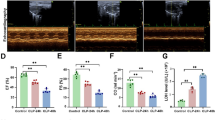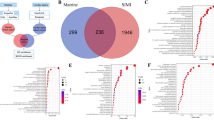Abstract
The main purpose of this study was to investigate effect of salidroside (Sal) on myocardial ischemia reperfusion injury in rats and the underlying mechanism. Myocardial ischemia reperfusion injury (MI/RI) model was treated with 30 min of left anterior descending (LAD) occlusion followed by 24 h of reperfusion. The male Sprague–Dawley rats were randomly divided into 7 groups: (1) Sham; (2) Sham + diltiazem (Dit, 10 mg/kg); (3) Sham + Sal (40 mg/kg); (4) I/R; (5) I/R + diltiazem (Dit, 10 mg/kg); (6) I/R + Sal (20 mg/kg); (7) I/R + Sal (40 mg/kg). Sal could ameliorate myocardial ischemia reperfusion injury as evidenced by Histopathological examination and triphenyl tetrazolium chloride (TTC) staining. Moreover, terminal deoxynucleotidyl transferase dUTP nickend labeling (TUNEL) assay demonstrated that Sal suppressed myocardial apoptosis, which may be related to up-regulation of Bcl-2/Bax ratio and inhibition of caspase-3, caspase-9 activation. Pretreatment with Sal affected serum biochemical parameters and cardiac dysfunction compared with I/R group. Sal also attenuated the pro-inflammatory cytokines including tumor necrosis factor-α (TNF-α), interleukin (IL)-1β and IL-6 in serum by inhibiting TLR4/NF-κB signaling pathway. Sal exerts strong favorable cardioprotective function on myocardial I/R injury which may relate to the down-regulation of the TLR4/NF-κB signaling pathway and the inhibition of cell apoptosis.









Similar content being viewed by others
References
Sivaraman V, Yellon DM (2014) Pharmacologic therapy that simulates conditioning for cardiac ischemic/reperfusion injury. J Cardiovasc Pharmacol Ther 19(1):83–96
Jennings RB, Sommers HM, Smyth GA, Flack HA, Linn H (1960) Myocardial necrosis induced by temporary occlusion of a coronary artery in the dog. Arch Pathol 70:68–78
Zahler S, Massoudy P, Hartl H, Hähnel C, Meisner H, Becker BF (1999) Acute cardiac inflammatory responses to postischemic reperfusion during cardiopulmonary bypass. Cardiovasc Res 41(3):722–730
Frangogiannis NG, Smith CW, Entman ML (2002) The inflammatory response in myocardial infarction. Cardiovasc Res 53:31–47
Fang L, Moore XL, Dart AM, Wang LM (2015) Systemic inflammatory response following acute myocardial infarction. J Geriatr Cardiol 12(3):305–312
Jennifer LS, Kasi VR, Jennifer LS (2009) Abstract 3610: direct thrombin inhibition limits ischemia and reperfusion injury in rats by decreasing oxidative stress, apoptosis, and inflammation. Circulation 120:835–836
Fliss H, Gattinger D (1996) Apoptosis in ischemic and reperfused rat myocardium. Circ Res 79(5):949–956
Anselmi A, Abbate A, Girola F, Nasso G, Biondi-Zoccai GG, Possati G et al (2004) Myocardial ischemia, stunning, inflammation, and apoptosis during cardiac surgery: a review of evidence. Eur J Cardiothorac Surg 25(3):304–311
Shevtsov VA, Zholus BI, Shervarly VI, Vol’skij VB, Korovin YP, Khristich MP (2003) A randomized trial of two different doses of a SHR-5 Rhodiola rosea extract versus placebo and control of capacity for mental work. Phytomedicine 10(2–3):95–105
De Bock K, Eijnde BO, Ramaekers M, Hespel P (2004) Acute Rhodiola rosea intake can improve endurance exercise performance. Int J Sport Nutr Exerc Metab 14(3):298–307
Qu ZQ, Zhou Y, Zeng YS, Lin YK, Li Y, Zhong ZQ et al (2012) Protective effects of a Rhodiola crenulata extract and salidroside on hippocampal neurogenesis against streptozotocin-induced neural injury in the rat. PLoS One 7(1):e29641
Zhu Y, Shi YP, Wu D, Ji YJ, Wang X, Chen HL et al (2011) Salidroside protects against hydrogen peroxide-induced injury in cardiac H9c2 cells via PI3K-Akt dependent pathway. DNA Cell Biol 30(10):809–819
Tan CB, Gao M, Xu WR, Yang XY, Zhu XM, Du GH (2009) Protective effects of salidroside on endothelial cell apoptosis induced by cobalt chloride. Biol Pharm Bull 32:1359–1363
Chen X, Zhang Q, Cheng Q, Ding F (2009) Protective effect of salidroside against H2O2-induced cell apoptosis in primary culture of rat hippocampal neurons. Mol Cell Biochem 332(1–2):85–93
Zhang L, Yu H, Sun Y, Lin X, Chen B, Tan C (2007) Protective effects of salidroside on hydrogen peroxide-induced apoptosis in SH-SY5Y human neuroblastoma cells. Eur J Pharmacol 564(1–3):18–25
Cao LL, Du GH, Wang MW (2006) The effect of salidroside on cell damage induced by glutamate and intracellular free calcium in PC12 cells. J Asian Nat Prod Res 8(1–2):159–165
Rossini R, Senni M, Musumeci G, Ferrazzi P, Gavazzi A (2010) Prevention of left ventricular remodelling after acute myocardial infarction: an update. Recent Pat Cardiovasc Drug Discov 5(3):196–207
Chen S, Liu J, Liu X, Fu Y, Zhang M, Lin Q et al (2011) Panaxnotoginsengsaponins inhibit ischemia-induced apoptosis by activating PI3K/Akt pathway in cardiomyocytes. J Ethnopharmacol 137(1):263–270
Kumar D, Jugdutt BI (2003) Apoptosis and oxidants in the heart. J Lab Clin Med 142(5):288–297
Cook SA, Sugden PH, Clerk A (1999) Regulation of bcl-2 family proteins during development and in response to oxidative stress in cardiac myocytes: association with changes in mitochondrial membrane potential. Circ Res 85(10):940–949
Lopez-Neblina F, Toledo AH, Toledo-Pereyra LH (2005) Molecular biology of apoptosis in ischemia and reperfusion. J Invest Surg 18(6):335–350
Dong JW, Zhu HF, Zhu WZ, Ding HL, Ma TM, Zhou ZN (2003) Intermittent hypoxia attenuates ischemia/reperfusion induced apoptosis in cardiac myocytes via regulating Bcl-2/Bax expression. Cell Res 13(5):385–391
Xiong J, Xue FS, Yuan YJ, Wang Q, Liao X, Wang WL (2010) Cholinergic anti-inflammatory pathway: a possible approach to protect against myocardial ischemia reperfusion injury. Chin Med J (Engl) 123(19):2720–2726
Ahn J, Kim J (2012) Mechanisms and consequences of inflammatory signaling in the myocardium. Curr Hypertens Rep 14(6):510–516
Otsui K, Inoue N, Kobayashi S, Shiraki R, Honjo T, Takahashi M et al (2007) Enhanced expression of TLR4 in smooth muscle cells in human atherosclerotic coronary arteries. Heart Vessels 22(6):416–422
Li Y, Si R, Feng Y (2011) Myocardial ischemia activates an injurious innate immune signaling via cardiac heat shock protein 60 and Toll-like receptor 4. J Biol Chem 286(36):31308–31319
Shimamoto A, Chong AJ, Yada M, Shomura S, Takayama H, Fleisig AJ et al (2006) Inhibition of Toll-like receptor 4 with eritoran attenuates myocardial ischemia–reperfusion injury. Circulation 114(1 Suppl):1270–1274
Oyama J, BlaisJr C, Liu X, Pu M, Kobzik L (2004) Reduced myocardial ischemia–reperfusion injury in Toll-like receptor 4-deficient mice. Circulation 109(6):784–789
Xu H, Yao Y, Su Z, Yang Y, Kao R, Martin CM et al (2010) Endogenous HMGB1 contributes to ischemia-reperfusion-induced myocardial apoptosis by potentiating the effect of TNF-α/JNK. Am J Physiol Heart Circ Physiol 300(3):H913–921
Ding HS, Yang J, Chen P, Yang J, Bo SQ, Ding JW (2013) The HMGB1-TLR4 axis contributes to myocardial ischemia/reperfusion injury via regulation of cardiomyocyte apoptosis. Gene 527(1):389–393
Chen CC, Young JL, Monzon RI, Chen N, Todorovic V, Lau LF (2007) Cytotoxicity of TNFalpha is regulated by integrin-mediated matrix signaling. EMBO J 26(5):1257–1267
Acknowledgments
This work was supported by the National Scientific & Technological major special Project “significant creation of new drugs” (2011ZX09102-002-01).
Author information
Authors and Affiliations
Corresponding authors
Ethics declarations
Conflict of interest
The authors have declared that there is no conflict of interest.
Rights and permissions
About this article
Cite this article
Zhu, L., Wei, T., Gao, J. et al. The cardioprotective effect of salidroside against myocardial ischemia reperfusion injury in rats by inhibiting apoptosis and inflammation. Apoptosis 20, 1433–1443 (2015). https://doi.org/10.1007/s10495-015-1174-5
Published:
Issue Date:
DOI: https://doi.org/10.1007/s10495-015-1174-5




